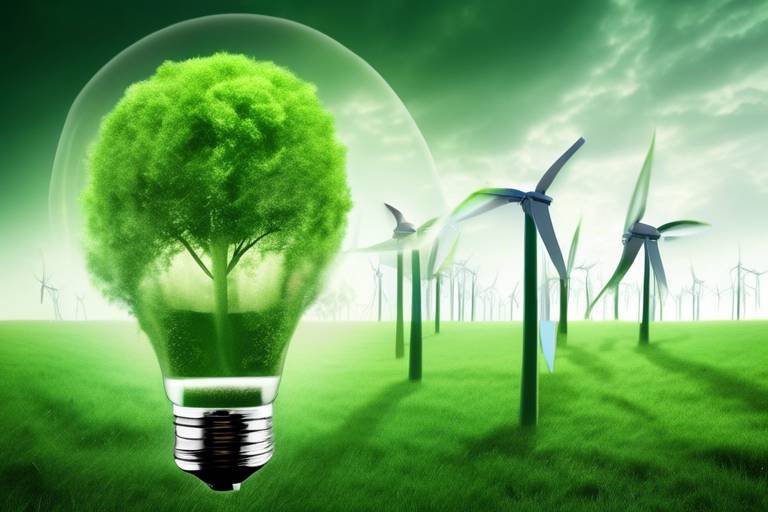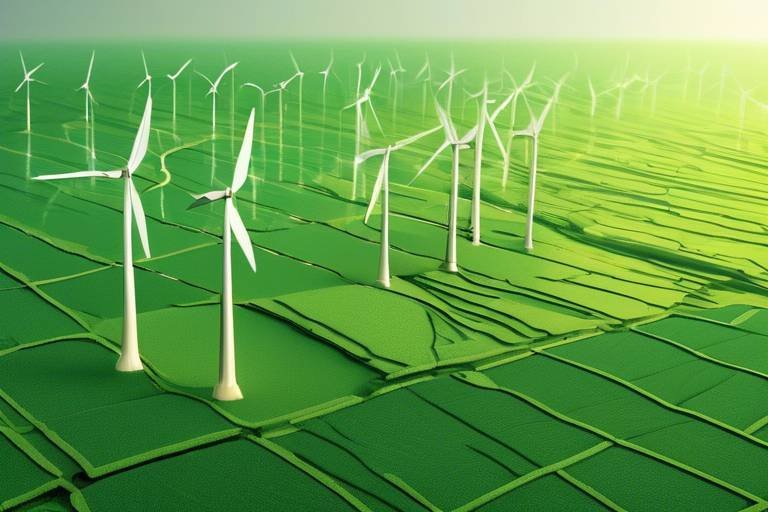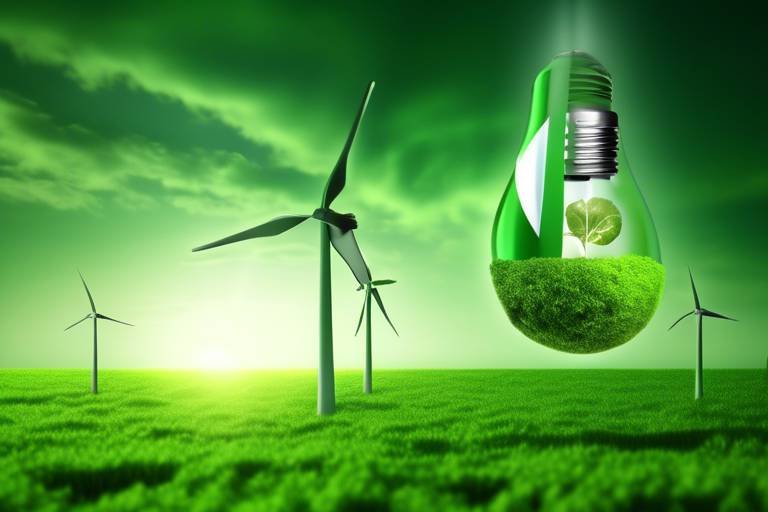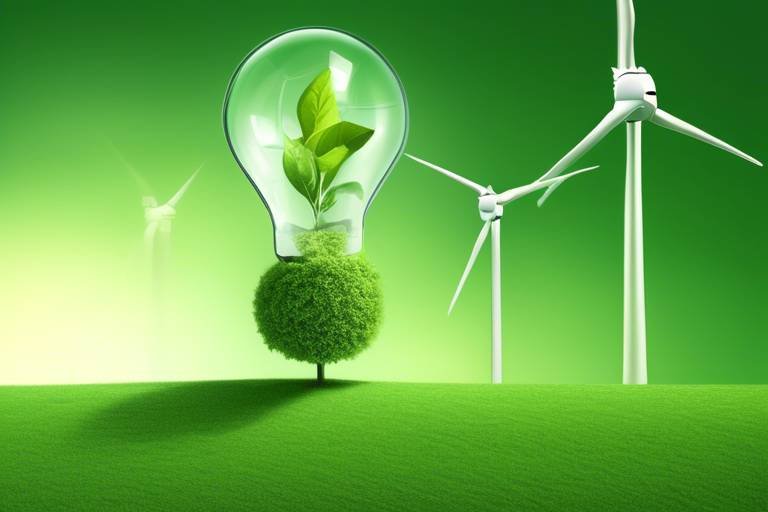Green Energy Storage – Overcoming Intermittency Issues
In a world increasingly driven by renewable energy, the challenge of energy storage has become a hot topic. As we shift away from fossil fuels, we face the daunting task of managing energy produced from sources like solar and wind, which are inherently intermittent. Imagine trying to fill a bathtub with a hose that only works sporadically; that's what energy systems face when relying solely on renewables. This article dives into the complexities of energy storage and explores innovative solutions that can help us achieve a stable, reliable, and sustainable energy future.
So, what exactly is energy intermittency? It's the term used to describe the fluctuations in energy production that occur with renewable sources. For instance, solar panels generate electricity only when the sun is shining, and wind turbines spin only when there's enough wind. This inconsistency can lead to significant challenges for energy systems and consumers alike. If you think about it, it's like trying to plan a picnic based on the weather—if it rains, your plans could be ruined!
These fluctuations can cause power shortages or surpluses, leading to grid instability and making it difficult to meet demand. As a result, energy providers must find ways to store excess energy generated during peak production times, so it can be used when production dips. This brings us to the heart of the issue: how do we store energy effectively?
Fortunately, there are several energy storage technologies designed to mitigate these intermittency issues. Each solution comes with its own set of advantages and limitations, making it crucial to understand the options available. Here are a few prominent types:
- Battery Storage: Particularly lithium-ion batteries, which are widely used today.
- Pumped Hydro: A well-established method that uses gravitational potential energy.
- Thermal Storage: Stores energy in the form of heat for later use.
Each of these technologies plays a vital role in ensuring that renewable energy can be harnessed effectively, but they also come with unique challenges that need to be addressed.
When it comes to energy storage, batteries are at the forefront of technology. Lithium-ion batteries, in particular, have revolutionized the way we store energy. They are not only efficient but also scalable, meaning they can be used in everything from small devices to large grid systems. Imagine having a power bank that could charge your entire neighborhood during an energy crisis—this is the potential of battery storage!
Recent advancements in battery technology have made them even more effective. Innovations like solid-state batteries promise to increase efficiency and lifespan significantly. These batteries use a solid electrolyte instead of a liquid one, which can enhance safety and energy density. Think of it as upgrading from a flimsy plastic water bottle to a durable stainless steel one—it's not just about looks; it's about performance!
However, battery storage isn't without its challenges. Issues such as high costs, resource availability, and recycling problems need to be addressed. For instance, the extraction of lithium and cobalt, key components in battery production, can lead to environmental concerns. It's like trying to solve a puzzle where some pieces are missing; we need to find ways to make battery production more sustainable and cost-effective.
Pumped hydro energy storage is another mature technology that offers significant capacity. This method works by pumping water uphill to a reservoir during times of low demand and releasing it to generate electricity when demand peaks. It's like having a giant water balloon that you can fill and then release when you need a burst of energy! However, it does require specific geographical conditions, which can limit its applicability in certain regions.
The energy storage landscape is continually evolving, with innovative solutions on the horizon. Technologies like flywheels, supercapacitors, and hydrogen storage are gaining traction and show promise in addressing the intermittency challenges of renewable energy.
Hydrogen storage, in particular, presents a fascinating option for long-term energy storage. By producing hydrogen through methods like electrolysis, we can store energy in a form that can be used later. It’s akin to filling a gas tank with potential energy that can be released when needed. This flexibility makes hydrogen a key player in achieving energy sustainability.
Finally, the integration of energy storage solutions with smart grids enhances energy management significantly. Smart grids utilize advanced technology to optimize energy distribution, making it easier to balance supply and demand. Imagine a traffic system that adjusts signals in real-time to prevent congestion—this is how smart grids operate, ensuring a more reliable energy supply for everyone.
Q: What is energy intermittency?
A: Energy intermittency refers to the fluctuations in energy production from renewable sources like solar and wind, which can lead to challenges in meeting energy demand.
Q: How do batteries help with energy storage?
A: Batteries, particularly lithium-ion, store excess energy generated during peak production times, allowing it to be used when production dips.
Q: What are the challenges of using pumped hydro energy storage?
A: While effective, pumped hydro requires specific geographical conditions and may not be feasible in all locations.
Q: What is the role of hydrogen in energy storage?
A: Hydrogen can be produced and stored for later use, providing a flexible energy source that can help balance supply and demand.

Understanding Energy Intermittency
Energy intermittency is a term that describes the unpredictable nature of energy production from renewable sources, such as solar and wind. Imagine trying to fill a bathtub with a hose that sometimes runs at full blast and sometimes barely drips; that’s the challenge we face with renewable energy. The sun doesn’t always shine, and the wind doesn’t always blow, leading to fluctuations in energy output that can create significant challenges for energy systems and consumers alike.
The implications of energy intermittency extend beyond mere inconvenience. For energy providers, it means they must constantly balance supply and demand, ensuring that when energy production dips, there is still enough power available to meet consumer needs. For consumers, this can lead to higher energy costs and potential disruptions in service. The reliance on renewable energy sources, while crucial for reducing carbon emissions, demands innovative solutions to manage these fluctuations effectively.
Several factors contribute to energy intermittency:
- Weather Variability: Changes in weather patterns can significantly impact solar and wind energy production.
- Seasonal Changes: Different seasons bring varying levels of sunlight and wind, affecting overall energy generation.
- Geographical Limitations: Some regions may have abundant renewable resources while others may not, leading to discrepancies in energy availability.
These factors highlight the importance of developing robust energy storage solutions and integrating them into our energy systems. Without addressing intermittency, the full potential of renewable energy cannot be realized, and our transition to a sustainable energy future may be jeopardized.
As we delve deeper into the world of energy storage technologies, we will uncover how various solutions can help mitigate the challenges posed by intermittency, ensuring a reliable and sustainable energy supply for all.
- What is energy intermittency? Energy intermittency refers to the fluctuations in energy production from renewable sources, influenced by factors like weather and seasonal changes.
- Why is energy intermittency a problem? It can lead to challenges in balancing supply and demand, potentially causing higher energy costs and service disruptions.
- How can we manage energy intermittency? By implementing effective energy storage solutions and integrating them with smart grid technologies, we can better manage and optimize energy distribution.

Types of Energy Storage Solutions
When it comes to managing the unpredictable nature of renewable energy, various energy storage solutions have emerged as essential tools in our quest for a sustainable future. These technologies not only help in storing excess energy generated during peak production times but also play a vital role in ensuring that power is available when demand surges. Let's dive into some of the most prominent types of energy storage solutions available today, each with its unique advantages and limitations.
Battery storage is perhaps the most widely recognized form of energy storage. Lithium-ion batteries, in particular, have gained immense popularity due to their high energy density and declining costs. These batteries can be deployed at various scales, from small residential systems to large utility-scale installations. However, while they are efficient and versatile, they also face challenges such as resource scarcity and environmental concerns related to mining and disposal.
Another significant player in the energy storage arena is pumped hydro energy storage. This technology has been around for decades and operates by using excess electricity to pump water uphill to a reservoir. When energy is needed, the stored water is released to generate electricity through turbines. Pumped hydro systems can provide large-scale energy storage, but their implementation is often limited by geographical factors, as they require suitable topography and water resources.
Thermal storage is another innovative solution that allows for the storage of excess energy in the form of heat. This method is particularly effective in solar thermal power plants, where heat is stored in materials like molten salt. When the sun isn’t shining, the stored heat can be used to produce steam and generate electricity. Although thermal storage is efficient, its application is primarily limited to specific energy generation technologies.
In addition to these established technologies, the energy storage landscape is evolving rapidly, with emerging solutions that promise to further enhance our energy systems. For instance, flywheels store energy in the form of kinetic energy, while supercapacitors offer rapid discharge capabilities, making them ideal for applications requiring quick bursts of energy. On the horizon, hydrogen storage is gaining traction as a versatile energy carrier, capable of addressing both short-term and long-term storage needs.
To summarize, the variety of energy storage solutions available today can be categorized into several types:
| Type | Key Features | Advantages | Limitations |
|---|---|---|---|
| Battery Storage | High energy density, scalable | Versatile, decreasing costs | Resource scarcity, recycling issues |
| Pumped Hydro | Mature technology, large capacity | High efficiency, long lifespan | Geographical limitations |
| Thermal Storage | Stores heat energy | Efficient for solar applications | Limited to specific technologies |
| Flywheels | Kinetic energy storage | Rapid discharge capabilities | Cost and complexity |
| Hydrogen Storage | Versatile energy carrier | Long-term storage potential | Infrastructure challenges |
As we explore these diverse energy storage solutions, it's clear that each comes with its own set of benefits and challenges. The key to a sustainable energy future lies in integrating these technologies into a cohesive system that can effectively manage the intermittency of renewable energy sources.

Battery Storage Technologies
Battery storage technologies are at the forefront of the renewable energy revolution, acting as the unsung heroes that help smooth out the bumps caused by energy intermittency. Imagine trying to fill a bathtub with water from a faucet that only flows sporadically; that's the challenge we face with renewable energy sources like solar and wind. They generate power based on environmental conditions, which can change rapidly. This is where battery storage steps in, capturing excess energy when production is high and releasing it when demand peaks. Among the various battery technologies, lithium-ion batteries have emerged as the most prevalent choice, thanks to their impressive performance and scalability.
Lithium-ion batteries work by moving lithium ions between two electrodes, and this process can be repeated thousands of times. Their high energy density means they can store a significant amount of energy in a relatively small space, making them ideal for everything from electric vehicles to grid-scale energy storage systems. However, they’re not without limitations. For instance, the availability of raw materials, such as lithium and cobalt, raises concerns about sustainability and environmental impact. Furthermore, the cost of battery production can be a barrier to widespread adoption. Despite these challenges, ongoing research is paving the way for advancements that promise to enhance the efficiency and lifespan of these batteries.
In addition to lithium-ion, other battery technologies are also gaining traction. For example, flow batteries offer a different approach by storing energy in liquid electrolytes, which can be scaled up easily for larger applications. This technology can potentially last longer and be cheaper to maintain than traditional batteries, but it currently lacks the energy density that lithium-ion batteries provide. Another promising contender is the sodium-ion battery, which utilizes sodium instead of lithium. Given that sodium is more abundant and cheaper, this could become a game-changer in making energy storage more accessible.
To give you a clearer picture, here’s a quick comparison of some popular battery technologies:
| Battery Type | Energy Density (Wh/kg) | Cost ($/kWh) | Life Cycle (cycles) |
|---|---|---|---|
| Lithium-Ion | 150-250 | 200-300 | 500-1500 |
| Flow Batteries | 20-40 | 300-500 | 2000+ |
| Sodium-Ion | 100-150 | 100-200 | 500-1000 |
As we delve deeper into the advancements in battery technology, we can’t ignore the exciting innovations on the horizon. Solid-state batteries, for instance, promise to replace the liquid electrolyte found in traditional batteries with a solid electrolyte, potentially increasing energy density and safety. Imagine a battery that could last for years without losing its ability to hold a charge—this could revolutionize everything from consumer electronics to electric vehicles.
However, as we celebrate these advancements, it's crucial to acknowledge the challenges that still lie ahead. The cost of production, the environmental impact of sourcing materials, and recycling issues are significant hurdles that the industry must overcome. As we push towards a more sustainable energy future, finding solutions to these challenges will be essential for the widespread adoption of battery storage technologies.

Advancements in Battery Technology
In recent years, the landscape of battery technology has undergone a remarkable transformation, paving the way for a more sustainable energy future. One of the most significant advancements has been in lithium-ion batteries, which are now more efficient and longer-lasting than ever before. These batteries have become the backbone of energy storage solutions, providing the necessary flexibility to manage the fluctuating supply from renewable sources like solar and wind. But what does the future hold? Let's dive into some of the exciting innovations that are reshaping this field.
One of the standout advancements is the development of solid-state batteries. Unlike traditional lithium-ion batteries that use liquid electrolytes, solid-state batteries utilize a solid electrolyte, which offers several advantages. For starters, they are generally safer, as they are less prone to overheating and catching fire. Additionally, they can potentially provide a higher energy density, meaning they can store more energy in a smaller space. This characteristic is crucial for applications ranging from electric vehicles to grid storage solutions, where space and weight are at a premium.
Another notable advancement is the emergence of lithium-sulfur batteries. These batteries promise to deliver much higher energy capacities than their lithium-ion counterparts. They operate on a different principle, using sulfur as the cathode material, which is abundant and inexpensive. However, challenges remain in terms of cycle stability and efficiency, but ongoing research is addressing these issues. If successful, lithium-sulfur batteries could revolutionize energy storage, making it more affordable and accessible.
Furthermore, researchers are exploring the potential of flow batteries, which store energy in liquid form. This technology is particularly beneficial for large-scale storage applications, as it allows for easy scalability. Flow batteries can be charged and discharged simultaneously, making them ideal for balancing supply and demand in renewable energy systems. They may not have the same energy density as lithium-ion batteries, but their longevity and ability to handle large amounts of energy make them a compelling option.
To put these advancements in perspective, consider the following table that summarizes key battery technologies and their characteristics:
| Battery Type | Energy Density (Wh/kg) | Cycle Life | Safety | Cost |
|---|---|---|---|---|
| Lithium-Ion | 150-250 | 500-2000 | Moderate | Moderate |
| Solid-State | 300-500 (theoretical) | 2000+ | High | High |
| Lithium-Sulfur | 400-600 (theoretical) | 300-500 | Moderate | Low |
| Flow Batteries | 20-40 | 5000+ | High | Moderate |
As we look ahead, the integration of artificial intelligence and machine learning into battery management systems is set to enhance the efficiency and reliability of these technologies even further. Imagine a world where your electric vehicle not only knows when to charge but also optimizes its energy usage based on your driving habits and local grid conditions. This level of sophistication could significantly reduce costs and improve the overall user experience.
In conclusion, the advancements in battery technology are not just technical improvements; they represent a paradigm shift in how we think about energy storage. With innovations like solid-state batteries and lithium-sulfur technology on the horizon, the future looks bright for renewable energy systems. These advancements will not only help mitigate the intermittency issues associated with renewable energy but also drive us closer to a sustainable energy future.
- What are the main advantages of solid-state batteries? Solid-state batteries offer higher energy density, improved safety, and longer cycle life compared to traditional lithium-ion batteries.
- How do flow batteries work? Flow batteries store energy in liquid form and can be charged and discharged simultaneously, making them ideal for large-scale energy storage applications.
- What is the future of lithium-sulfur batteries? While they promise higher energy capacities, ongoing research is needed to address challenges related to cycle stability and efficiency.

Challenges of Battery Storage
While battery storage systems, especially lithium-ion batteries, have revolutionized the way we think about energy storage, they are not without their challenges. One of the most pressing issues is the cost associated with these technologies. Despite decreasing prices over the years, the initial investment for large-scale battery systems can still be quite significant. This can deter many potential users, particularly in developing regions where budgets are already strained.
Another challenge lies in the availability of resources needed for battery production. Lithium, cobalt, and nickel are essential components of lithium-ion batteries, and their extraction can lead to environmental degradation and geopolitical tensions. As demand for batteries grows, so does the pressure on these resources, raising concerns about sustainability and ethical sourcing.
Moreover, the recycling of batteries presents a formidable challenge. While battery technology has advanced, the recycling processes have not kept pace. Currently, only a fraction of used batteries are recycled, leading to significant waste and environmental hazards. The development of efficient recycling methods is critical to ensuring that battery storage remains a viable solution for the future.
Additionally, the performance of batteries can degrade over time. Factors such as temperature fluctuations, charge cycles, and overall usage can affect their lifespan and efficiency. Users often face the dilemma of whether to invest in new batteries or continue using older models that may not perform optimally.
Lastly, there are technological limitations that still need addressing. Current battery technologies may not always provide the necessary energy density or power output for certain applications. For instance, in large-scale energy storage, the need for high capacity and rapid discharge can be challenging to meet with existing battery technologies.
In conclusion, while battery storage offers a promising solution to energy intermittency, its challenges cannot be overlooked. Addressing these concerns through innovation, sustainable practices, and improved recycling methods will be essential for the future of energy storage systems.
- What are the main challenges of battery storage? The main challenges include cost, resource availability, recycling issues, performance degradation, and technological limitations.
- How can we improve battery recycling? Developing efficient recycling processes and encouraging manufacturers to design batteries for easier recycling can help.
- Are there alternatives to lithium-ion batteries? Yes, alternatives include solid-state batteries, flow batteries, and even emerging technologies like hydrogen storage.

Pumped Hydro Energy Storage
Pumped hydro energy storage (PHES) has been a cornerstone of energy storage technology for decades, and for good reason. Imagine a giant water reservoir perched high in the mountains, ready to unleash its potential energy whenever needed. This method works by using excess electricity to pump water from a lower reservoir to an upper one during periods of low demand. When energy is needed, the stored water is released back down, spinning turbines that generate electricity. It's a classic example of using gravity and water to create a reliable energy source that can be tapped into when the sun isn't shining or the wind isn't blowing.
One of the biggest advantages of pumped hydro is its ability to store large amounts of energy. In fact, it accounts for about 95% of the world’s grid-scale energy storage capacity. This makes it a key player in balancing supply and demand in energy systems. However, while the technology is mature and proven, it does come with its own set of challenges. For starters, the geographical limitations can restrict where these systems can be built. Not every location has the right topography or water resources to support a pumped hydro setup. Additionally, the construction of such facilities can be quite expensive and time-consuming.
Despite these limitations, the benefits of pumped hydro are hard to ignore. Here’s a quick overview of some of its key benefits and challenges:
| Benefits | Challenges |
|---|---|
| High capacity for energy storage | Geographical limitations |
| Long lifespan and reliability | High construction costs |
| Proven technology with a track record | Environmental impact concerns |
In essence, pumped hydro energy storage not only provides a solution to the intermittency issues faced by renewable energy sources but also contributes to grid stability. It acts as a giant battery, storing energy when it's abundant and releasing it when it's scarce. As we continue to transition towards a more sustainable energy future, enhancing the efficiency and capacity of pumped hydro systems will be crucial. It’s like having a reliable friend who’s always there to help out when times get tough, ensuring that our energy needs are met even when the skies are cloudy or the winds are still.
- What is pumped hydro energy storage? - It is a method of storing energy by using excess electricity to pump water to a higher elevation, and then releasing it to generate electricity when needed.
- What are the advantages of pumped hydro? - It offers high storage capacity, long lifespan, and proven reliability.
- What challenges does pumped hydro face? - Geographical limitations, high construction costs, and potential environmental impacts.
- Is pumped hydro energy storage environmentally friendly? - While it is more sustainable than fossil fuels, there can be environmental concerns related to the construction of reservoirs and their impact on local ecosystems.

Emerging Energy Storage Technologies
As we venture deeper into the realm of renewable energy, the need for innovative energy storage solutions has never been more pressing. The traditional methods of energy storage, while effective, often fall short in meeting the demands of a rapidly changing energy landscape. This is where come into play, offering exciting possibilities that could redefine how we store and utilize energy.
One of the most promising avenues is the development of flywheel energy storage. Flywheels store energy in the form of kinetic energy, using a rotating mass. When energy is needed, the flywheel releases this stored energy back into the system. This technology boasts several advantages, including rapid response times and a long lifespan, making it an excellent candidate for balancing supply and demand in real-time. However, it’s essential to consider that flywheels require a significant amount of initial energy to get spinning, which can be a drawback in some scenarios.
Another innovative solution gaining traction is supercapacitors. Unlike traditional batteries, supercapacitors store energy electrostatically rather than chemically. This allows them to charge and discharge much faster, making them ideal for applications that require quick bursts of energy. For instance, they can be used in electric vehicles to provide the extra power needed during acceleration. However, while they excel in power density, their energy density is lower than that of batteries, meaning they can’t store as much energy for extended periods.
Then we have hydrogen storage, which is emerging as a strong contender for long-term energy storage solutions. Hydrogen can be produced through various methods, including electrolysis, where water is split into hydrogen and oxygen using electricity. This hydrogen can then be stored and used later as a fuel source. The beauty of hydrogen lies in its versatility; it can be utilized in fuel cells to generate electricity or burned directly for heat. However, the infrastructure for hydrogen production and distribution is still in its infancy, posing a challenge for widespread adoption.
In addition to these technologies, there are also advancements in thermal energy storage. This method involves storing energy in the form of heat, which can be used later to generate electricity or provide heating. For example, molten salt is often used in concentrated solar power plants to store heat generated during the day, which can then be converted to electricity when the sun isn’t shining. While thermal storage is highly effective, it is typically limited to specific applications and requires careful management of heat loss.
Ultimately, the emergence of these technologies signifies a shift towards a more resilient and flexible energy system. As we continue to innovate and explore new methods of energy storage, we pave the way for a sustainable energy future that can adapt to the challenges of intermittency. The integration of these technologies into our existing energy infrastructure will be crucial in overcoming current limitations and maximizing the potential of renewable energy sources.
- What are emerging energy storage technologies? Emerging energy storage technologies include innovative systems such as flywheels, supercapacitors, and hydrogen storage, which aim to enhance the efficiency and reliability of energy storage.
- How does hydrogen storage work? Hydrogen storage involves producing hydrogen through methods like electrolysis, storing it, and then using it later as a fuel source for generating electricity or heating.
- What are the advantages of flywheel energy storage? Flywheel energy storage systems offer rapid response times, long lifespans, and the ability to balance supply and demand in real-time.
- Can supercapacitors replace batteries? While supercapacitors excel in quick energy discharge and charge times, they currently cannot match the energy density of batteries, making them suitable for different applications.

Hydrogen as an Energy Carrier
Hydrogen has emerged as a game-changer in the quest for sustainable energy solutions. As an energy carrier, it has the potential to store and transport energy efficiently, making it a vital component in our transition to a greener future. Imagine hydrogen as a versatile delivery truck for energy; it can pick up energy from various sources, store it, and drop it off where it's needed, all while emitting nothing but water vapor as a byproduct. This ability to act as a bridge between energy generation and consumption is what makes hydrogen so appealing.
One of the most fascinating aspects of hydrogen is its production methods. There are several ways to produce hydrogen, but the most common methods include:
- Electrolysis: This process uses electricity to split water into hydrogen and oxygen. If the electricity comes from renewable sources, such as solar or wind, the hydrogen produced is considered green hydrogen.
- Steam Methane Reforming (SMR): This is a more traditional method where natural gas is used to produce hydrogen. While it's currently the most economical method, it does release carbon dioxide, which raises environmental concerns.
- Gasification: This involves converting organic or fossil-based materials into hydrogen and other products through high-temperature processing.
Once produced, hydrogen can be stored in various forms, including compressed gas, liquid hydrogen, or even in chemical compounds. Each method of storage has its own advantages and limitations. For instance, compressed hydrogen is easier to transport but requires high-pressure tanks, while liquid hydrogen is denser and can be stored at lower pressures but demands extremely low temperatures.
Hydrogen's role as an energy carrier extends beyond just storage. It can also be used in fuel cells, which convert hydrogen back into electricity with high efficiency. This means that hydrogen can be utilized not only for storing energy but also for generating clean electricity when needed. Think of fuel cells as the reverse of electrolyzers; they take hydrogen and oxygen and create electricity, making them perfect for powering vehicles, homes, and industries. The potential for hydrogen fuel cells in transportation, especially in heavy-duty vehicles and public transport, is particularly exciting, as they provide a clean alternative to fossil fuels.
Moreover, hydrogen can play a crucial role in decarbonizing sectors that are hard to electrify, such as heavy industry and shipping. By using hydrogen as a feedstock or fuel, these industries can significantly reduce their carbon footprint. This versatility positions hydrogen as a key player in the global effort to combat climate change.
However, despite its promise, the widespread adoption of hydrogen as an energy carrier faces several challenges. The infrastructure for hydrogen production, storage, and distribution is still in its infancy. Building a robust hydrogen economy will require significant investments and innovations. Additionally, the cost of green hydrogen production needs to decrease to become competitive with traditional fuels.
In summary, hydrogen is not just a buzzword; it represents a transformative opportunity in the energy landscape. By harnessing its potential, we can create a more sustainable and resilient energy system that meets the demands of the future. As we continue to explore and invest in hydrogen technologies, we move closer to a world where clean energy is accessible to all.
Q: What is hydrogen energy?
A: Hydrogen energy refers to the use of hydrogen as a fuel source to generate power, either through combustion or in fuel cells, producing only water as a byproduct.
Q: How is hydrogen produced?
A: Hydrogen can be produced through various methods, including electrolysis of water, steam methane reforming, and gasification of organic materials.
Q: What are the advantages of hydrogen as an energy carrier?
A: Hydrogen can store large amounts of energy, is versatile in use, produces no carbon emissions when burned or used in fuel cells, and can help decarbonize various sectors.
Q: What challenges does hydrogen face?
A: The main challenges include high production costs, the need for extensive infrastructure development, and ensuring safe storage and transportation methods.

Integrating Storage with Smart Grids
Integrating energy storage with smart grids is like putting the final piece into a complex puzzle. It creates a seamless synergy between energy generation, distribution, and consumption, paving the way for a more sustainable and efficient energy future. Smart grids utilize advanced technology to monitor and manage the flow of electricity, allowing for real-time adjustments based on supply and demand. This integration not only enhances the reliability of renewable energy systems but also empowers consumers to take control of their energy usage.
Imagine a world where your home can not only consume energy but also store it and sell it back to the grid when demand peaks. This is made possible through the integration of battery storage systems with smart grids. For instance, during the day when solar panels are generating surplus energy, homes equipped with battery storage can store this excess power. Later, during the evening when energy demand spikes, these homes can draw from their stored energy or feed it back into the grid. This dynamic interaction helps stabilize the grid and reduces the need for fossil fuel-based peaker plants.
Moreover, smart grids facilitate the use of demand response programs. These programs incentivize consumers to reduce or shift their energy usage during peak periods. By integrating storage solutions, consumers can participate more effectively in these programs. For example, a household with a smart battery can receive notifications to discharge energy back to the grid during peak hours, earning financial rewards while contributing to grid stability. This not only benefits the individual consumer but also supports the overall health of the energy system.
Additionally, the integration of storage with smart grids enables better forecasting and management of renewable energy sources. By utilizing advanced algorithms and data analytics, grid operators can predict energy production from sources like solar and wind. This predictive capability allows for optimized energy storage and distribution strategies, ensuring that energy is available when and where it is needed most. The result? A more resilient grid that can handle the fluctuations inherent in renewable energy production.
However, the transition to smart grids integrated with energy storage does come with its challenges. Issues such as interoperability between different technologies, regulatory hurdles, and the need for significant infrastructure investments can pose obstacles. Yet, the benefits far outweigh these challenges. With ongoing advancements in technology and increasing investments in renewable energy, the integration of storage with smart grids is not just a possibility; it is becoming a reality.
In conclusion, the integration of energy storage with smart grids represents a transformative leap towards a more efficient, reliable, and sustainable energy future. As we continue to innovate and adapt, this synergy will play a crucial role in overcoming the challenges of energy intermittency, ultimately benefiting consumers and the environment alike.
- What is a smart grid? A smart grid is an electricity supply network that uses digital technology to monitor and manage the transport of electricity from all generation sources to meet the varying electricity demands of end-users.
- How does energy storage enhance smart grids? Energy storage systems help balance supply and demand, store excess energy, and provide backup power, enhancing the overall reliability and efficiency of smart grids.
- What are the benefits of integrating energy storage with smart grids? Benefits include improved grid reliability, reduced energy costs, increased use of renewable energy, and enhanced consumer participation in energy management.
- What challenges exist in integrating storage with smart grids? Challenges include interoperability issues, regulatory barriers, and the need for significant infrastructure investments.
Frequently Asked Questions
- What is energy intermittency?
Energy intermittency refers to the unpredictable fluctuations in energy production from renewable sources like solar and wind. These fluctuations can occur due to changes in weather conditions, making it challenging to provide a consistent energy supply.
- How do energy storage solutions help with intermittency?
Energy storage solutions, such as batteries and pumped hydro systems, act like sponges that soak up excess energy when production is high and release it when production dips. This balancing act ensures a stable energy supply, even when renewable sources are not generating power.
- What types of energy storage technologies are available?
There are several energy storage technologies available, including battery storage (like lithium-ion), pumped hydro storage, and thermal storage. Each has its own set of advantages and limitations, depending on factors like capacity, cost, and geographical suitability.
- What are the advantages of battery storage?
Battery storage systems are highly scalable, can be deployed quickly, and have a wide range of applications. They can store energy from renewable sources and release it when needed, making them a vital component of modern energy systems.
- What challenges do battery storage technologies face?
Despite their benefits, battery storage technologies face challenges such as high costs, limited resource availability for production, and concerns regarding recycling and environmental impact. Addressing these challenges is crucial for the widespread adoption of battery storage.
- How does pumped hydro energy storage work?
Pumped hydro energy storage utilizes two water reservoirs at different elevations. When there is excess energy, water is pumped from the lower reservoir to the upper one. When energy is needed, the water flows back down, turning turbines to generate electricity.
- What are emerging energy storage technologies?
Emerging energy storage technologies include flywheels, supercapacitors, and hydrogen storage. These innovations aim to improve energy storage efficiency and capacity, offering new solutions to meet the demands of a renewable energy future.
- How does hydrogen storage work?
Hydrogen storage involves producing hydrogen through methods like electrolysis and storing it for later use. When needed, hydrogen can be converted back into electricity or used as a fuel, making it a versatile option for long-term energy storage.
- What role do smart grids play in energy storage?
Smart grids enhance energy management by integrating storage solutions and optimizing energy distribution. They use advanced technology to monitor and control energy flow, improving reliability and efficiency in renewable energy systems.


















